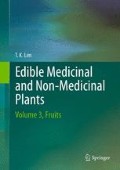Abstract
Acerola is indigenous to the Lesser Antilles from St. Croix to Trinidad, also Curacao and Margarita and neighbouring Central America including Mexico and southern Texas and northern South America as far south as Bahia in Brazil. It has become naturalized in Cuba, Jamaica and Puerto Rico after cultivation, and is commonly grown in house yards in the Bahamas and Bermuda, and to a lesser extent in Central and South America. It is now cultivated globally in the tropics and subtropics in Australia, Brazil, Canary Islands, Cuba, Ethiopia, French Guiana, Ghana, Hawaii, India, Indonesia, Jamaica, Madagascar, Pakistan, Peru, Philippines, Puerto Rico, Sri Lanka, Surinam, Taiwan, Thailand, Myanmar, Venezuela, Vietnam and Zanzibar.
Access this chapter
Tax calculation will be finalised at checkout
Purchases are for personal use only
Selected References
Backer CA, Van der Bakhuizen Brink RC Jr (1963) Flora of Java, vol 1. Noordhoff, Groningen, 648 pp
Council of Scientific and Industrial Research (1962) The wealth of India. A dictionary of Indian raw materials and industrial products. (Raw materials 6). Publications and Information Directorate, New Delhi, India
Hanamura T, Aoki H (2008) Toxicological evaluation of polyphenol extract from acerola (Malpighia emarginata DC.) fruit. J Food Sci 73(4):T55–T61
Hanamura T, Hagiwara T, Kawagishi H (2005) Structural and functional characterization of polyphenols isolated from acerola (Malpighia emarginata DC.) fruit. Biosci Biotechnol Biochem 69(2):280–286
Hanamura T, Mayama C, Aoki H, Hirayama Y, Shimizu M (2006) Antihyperglycemic effect of polyphenols from acerola (Malpighia emarginata DC.) fruit. Biosci Biotechnol Biochem 70(8):1813–1820
Hanamura T, Uchida E, Aoki H (2008) Skin-lightening effect of a polyphenol extract from acerola (Malpighia emarginata DC.) fruit on UV-induced pigmentation. Biosci Biotechnol Biochem 72(12):3211–3218
Harjadi SS (1992) Malpighia glabra L. In: Verheij EWM, Coronel RE (eds) Plant resources of South-East Asia, no 2. Edible fruits and nuts. Prosea Foundation, Bogor, pp 198–200
Kawaguchi M, Tanabe H, Nagamine K (2007) Isolation and characterization of a novel flavonoid possessing a 4, 2’’-glycosidic linkage from green mature acerola (Malpighia emarginata DC.) fruit. Biosci Biotechnol Biochem 71(5):1130–1135
Kuskoski EM, Asuero AG, Morales MT, Fett R (2006) Roseane. Frutos tropicais silvestres e polpas de frutas congeladas: atividade antioxidante, polifenóis e antocianinas. Cienc Rural 36(4):1283–1287 (Wild fruits and pulps of frozen fruits: antioxidant activity, polyphenols and anthocyanins)
Ledin RB (1958) The Barbados or West Indian cherry. Fla Agric Exp Stn Bull 594:1–28
Lorenzi H, Bacher L, Lacerda M, Sartori S (2006) Brazilian fruits & cultivated exotics (for consuming in Natura). Instituto Plantarum de Etodos da Flora Ltda, Brazil, 740 pp
Mezadri T, Pérez-Gálvez A, Hornero-Méndez D (2005) Carotenoid pigments in acerola fruits (Malpighia emarginata DC.) and derived products. Eur Food Res Technol 220(1):63–69
Mezadri T, Fernández-Pachón MS, Villaño D, García-Parrilla MC, Troncoso AM (2006) The acerola fruit: composition, productive characteristics and economic importance. Arch Latinoam Nutr 56(2):101–109, In Spanish
Morton JF (1987) Barbados cherry. In: Fruits of warm climates. Julia F. Morton, Miami, pp 204–207
Moscoco CG (1956) West Indian cherry - richest known source of natural vitamin C. Econ Bot 10:280–294
Motohashi N, Wakabayashi H, Kurihara T, Fukushima H, Yamada T, Kawase M, Sohara Y, Tani S, Shirataki Y, Sakagami H, Satoh K, Nakashima H, Molnár A, Spengler G, Gyémánt N, Ugocsai K, Molnár J (2004) Biological activity of Barbados cherry (acerola fruits, fruit of Malpighia emarginata DC) extracts and fractions. Phytother Res 18(3):212–223
Ostendorf FW (1963) The West Indian cherry. Trop Abstr 18(3):145–150
Pereira AC, Siqueira AM, Farias JM, Maia GA, Figueiredo RW, Sousa PH (2009) Development of mixed drink of coconut water, pineapple and acerola pulp. Arch Latinoam Nutr 59(4):441–447, In Spanish
Pino JA, Marbot R (2001) Volatile flavour constituents of acerola (Malpighia emarginata DC.) fruit. J Agric Food Chem 49(12):5880–5882
Purseglove JW (1968) Tropical crops: Dicotyledons 1 & 2. Longman, London, 719 pp
Tropicos Org. Missouri Botanical Garden Jan 2009. http://www.tropicos.org
U.S. Department of Agriculture, Agricultural Research Service (2010) USDA National Nutrient Database for Standard Reference, Release 23. Nutrient Data Laboratory Home Page, http://www.ars.usda.gov/ba/bhnrc/ndl
Visentainer JV, Vieira OA, Matsushita M, de Souza NE (1997) Physico-chemical characterization of acerola (Malpighia glabra L.) produced in Maringá, Paraná state, Brazil. Arch Latinoam Nutr 47(1):70–72, In Portuguese
Wakabayashi H, Fukushima H, Yamada T, Kawase M, Shirataki Y, Satoh K, Tobe T, Hashimoto K, Kurihara T, Motohashi N, Sakagami H (2003) Inhibition of LPS-stimulated NO production in mouse macrophage-like cells by Barbados cherry, a fruit of Malpighia emarginata DC. Anticancer Res 23(4):3237–3241
Author information
Authors and Affiliations
Corresponding author
Rights and permissions
Copyright information
© 2012 Springer Science+Business Media B.V.
About this chapter
Cite this chapter
Lim, T.K. (2012). Malpighia emarginata. In: Edible Medicinal And Non Medicinal Plants. Springer, Dordrecht. https://doi.org/10.1007/978-94-007-2534-8_20
Download citation
DOI: https://doi.org/10.1007/978-94-007-2534-8_20
Published:
Publisher Name: Springer, Dordrecht
Print ISBN: 978-94-007-2533-1
Online ISBN: 978-94-007-2534-8
eBook Packages: Biomedical and Life SciencesBiomedical and Life Sciences (R0)

